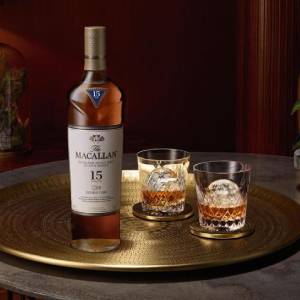Hedonism Meets... Agustín Santolaya

One of Rioja’s most forward-thinking producers, Bodegas Roda wines have met with international acclaim since the company was founded in 1987 by drinks distributors Mario Rotllant and Carmen Daurell. From old vines to wild yeasts, sustainability to the importance of standing out from the crowd, Bodegas Roda wines are a true expression of the vintages and terroir that shape the native varieties of Tempranillo, Garnacha and Graciano.
We caught up with Agustín Santolaya, Managing Director and Head Winemaker of Bodegas Roda to find out just what it is about this legendary Spanish wine producer that make the wines so globally prized...
"We wanted it to be a wine that could be enjoyed in its youth and that would also live on for decades"
Can you tell us a little about your own personal journey and career with Bodegas Roda?
I joined Bodegas Roda in January 1992, together with Isidro Palacios [Technical Director of Viticulture]. Carlos Díez [Director of Winemaking] had arrived a few months earlier. Led by winery co-owner, Mario Rotllant, we started out on this exciting journey as a team. Coming from a family of winegrowers, my life has always centred around the vineyard and the world of wine.
I met Isidro when studying for my Masters in Viticulture and Oenology back in 1988. We focused on wine consulting and advised on new projects. I taught viticulture at the University of La Rioja and was in charge of the family farm. Although Isidro and I came to Roda principally to manage viticulture and the new vineyards, we soon became part of a multidisciplinary team involved in developing all aspects of the technical side of the business.
Mario wanted a team of well-trained young people who were not shaped by ideas and approaches learnt at other wineries. José Raventós soon joined the team to manage the sales department. The four of us formed a team headed up by Mario in which we had equal decision-making power, with Mario only casting the deciding vote if a consensus was not reached. This is how we became a strong team. In 1998 I was appointed Managing Director. I have held the position ever since, but that initial decision-making structure has remained a key part of Bodegas Roda’s approach: we continue to work and make decisions as a team.
Your super-premium Rioja, Cirsion is made from a selection of very old vines from over 30 vineyards. At a time when the importance of old vines is being truly recognised (for example with the success of this year’s Old Vine Conference), can you tell us a little about the role of old vines in your wines? Why are old vines important in in the production of high quality, ageworthy wines?
It is firstly important to clarify that old vines do not necessarily make for high quality grapes. There are many old vineyards which are grown on unsuitable soil or using low quality plant material which yield low quality grapes. What is true however is that, all things being equal, an old vineyard is better than a young one. The reason behind this lies in the magic word for viticulture: balance.
Balance means that there are only small numbers of well-aerated, loose bunches, with sufficient leaves to enable the berries to develop and ripen. Old vines have a very deep, penetrating root system and are not as sensitive to the vagaries of the weather. The vascular system in old vines is much more twisted, meaning that the soil solution travels slowly to the leaves and bunches. Old vines are also capable of transmitting a deeper minerality. The grapes can be excellent and well-balanced.

We are really excited about the release of the new 2018 Cirsion vintage. What makes this vintage a special year?
The 2018 vintage was fresh, with good rainfall and late harvest in mid-October. Such conditions usually make for a difficult harvest in young vineyards, but the old low-yielding vines achieved a slow and perfect ripeness, producing more restrained and elegant wines. This is what defines Cirsion 2018: it is a voluminous and ethereal wine, subtle and fresh, yet very long and silky.
Extensive aging requirements and the predominant use of traditionally American oak have long characterised Rioja production. How and why do Bodegas Roda seek to do things differently and break the mould?
The concept behind Cirsion is very special. Back in 1995, Isidro and I observed interesting variations and different ripeness levels in grapes from different vines in the same old vine vineyard. Some vines, whether due to genetic makeup or other factors, produced grapes of such excellent ripeness that the tannins had already become rounded and smooth whilst on the vine. We thought that if we harvested those grapes separately, we could make a different wine. We made an experimental batch back in 1997 and fell in love with the result. Then we wondered: if the tannins were so silky, did we need so much time in barrel? Indeed, although barrel ageing can smooth out tannins, it can also reduce the fruitiness and vineyard nuances in a wine. This is why Cirsion wines undergo the shortest aging periods in our range. We continue to produce Cirsion from the grapes of a few selected vines from our oldest vineyards.
“Cirsion has become, vintage after vintage, a wine of legendary status, bringing a breath-taking complexity and subtlety to the glass. Ethereal and weightless, it captures the palate with its nuanced freshness.”
How are the effects of global warming being felt in the vineyard? What is Bodegas Roda doing to tackle these challenges in the vineyard and winery?
The effects of global warming are very apparent. Since Roda began we have seen a 0.5% abv increase per decade, rising from 13% to 14.5% abv. The pH is higher and there is greater warmth in the wines. At Bodegas Roda we actively taken steps to tackle this challenge:
- Since 2012, we blend a percentage of Graciano in our Cirsion wines. Graciano is a variety with a much lower pH that works well with Tempranillo.
- We are using clonal selection with Tempranillo to identify the clones that are best suited to these climatic changes, so as to give lower alcohol levels and higher acidity.
- We are extending our vineyards to North and Northwesterly latitudes.
- We are planting on higher and cooler sites.
- We are harvesting earlier.
At Hedonism we are delighted to have a range of Roda wines in large formats (ranging from 150 - 1800 cl). In your experience, have you seen any difference in large format wines in terms of their ageability and ability to evolve (compared with standard 75cl formats)?
Indeed. In large formats, the ratio between the stopper surface area and the wine volume is much smaller which slows the evolution of the wine.
What have the challenges been for Bodegas Roda in being a relative newcomer to the Rioja scene (1990s)?
We wanted to make something different yet complementary to the other great Riojas already being made. A wine that would embody the expression of the landscape and vintage rather than the winemaking. A wine that would prove a success with consumers. We wanted it to be a wine that could be both enjoyed in its youth and that would also live on for decades. We do not blend even the smallest drop of one vintage with another: our wines are pure single vintage expressions.
Sustainability has always been key to our approach: we do not use herbicides or chemicals and we practice dry farming. Our use of wild yeasts, introduction of the first sorting table in the appellation and a return to French oak fermenters are a few examples of what makes Bodegas Roda unique. We were known as the modern guys; now we are the most classical of the modern wineries or the most modern of classical wineries!

Can you tell our readers a little about your two main wine ranges: Roda I and Cirsion and what makes them so unique?
We vinify and age the grapes from our vineyards separately (some 30 vineyards). The climatic interaction of Continental, Mediterranean and Atlantic influences in our region mean that some vineyards display a fresher and more delicate red fruit profile, whilst others show a deeper, dark fruit driven profile which is more complex and mineral. The former, with their red character, are used to produce of Roda wines, as indicated by the red foil on the capsule. The latter, with their dark fruit profile, become components of Roda I wines, which bear a black foil.
Roda I is undoubtedly one the best expressions of Tempranillo in the world. A balanced wine of absolute elegance, which crucially expresses the unique character of the landscape and the vintage. The oak encases the fruit without dominating it, the tannins are silky, there is good volume and freshness. Cirsion has become, vintage after vintage, a wine of legendary status, bringing breath-taking complexity and subtlety to the glass. Ethereal and weightless, it captures the palate with its nuanced freshness.
What are the considerations that go into your varietal blending choices (Tempranillo, Garnacha, Graciano)?
Each variety is different. Tempranillo forms the backbone of our wines. We believe it to be one of the world’s finest varieties, with sweet tannins that make it easy to enjoy in its youth whilst also having significant ageing potential. Graciano brings freshness and complements Tempranillo very well. In the face of global warming, this is certainly a variety with a promising future. We focus less on Garnacha, but it brings finesse and delicacy.
What new innovations or exciting plans do you have for Bodegas Roda in the coming years?
In Rioja we have just planted a truly revolutionary new vineyard. We have adopted a regenerative viticulture approach and the vineyard is planted using the Keyline system to avoid soil erosion. The sweeping curves of the vineyard are truly spectacular.
Below are a few highlights from the Bodegas Roda range. Click here to view our full selection.





















